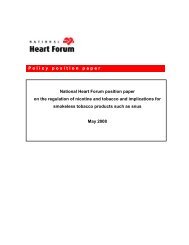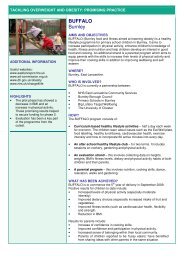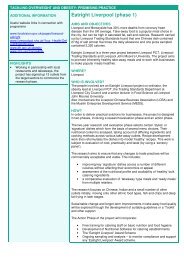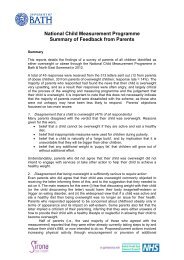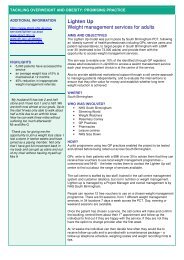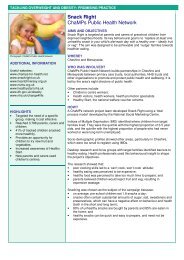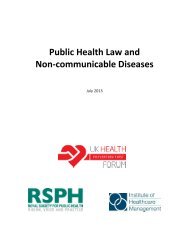The Challenge of Non-Communicable Diseases and Road Traffic ...
The Challenge of Non-Communicable Diseases and Road Traffic ...
The Challenge of Non-Communicable Diseases and Road Traffic ...
Create successful ePaper yourself
Turn your PDF publications into a flip-book with our unique Google optimized e-Paper software.
5. A COMPREHENSIVE, INTEGRATED<br />
APPROACH TO NCDs AND ROAD SAFETY<br />
In this section, the elements <strong>of</strong> a comprehensive approach<br />
to NCD <strong>and</strong> road safety control are considered.<br />
It draws on the available literature, <strong>and</strong> explores<br />
the potential for adopting shared approaches with<br />
other conditions. <strong>The</strong> section covers the following:<br />
• Policy approaches<br />
• Population-level prevention<br />
• Individual-level prevention<br />
• <strong>The</strong>rapies – treatment, care, <strong>and</strong> rehabilitation<br />
• Strengthening health systems<br />
• Addressing information <strong>and</strong> health gaps<br />
• <strong>The</strong> role <strong>of</strong> public <strong>and</strong> private employers <strong>and</strong> businesses.<br />
5.1. Policy Approach<br />
Improving Commitment <strong>and</strong> Response<br />
An important starting point for action is clear government<br />
acknowledgement <strong>of</strong> the problem <strong>and</strong><br />
commitment to address the issue [179]. <strong>The</strong>re is evidence<br />
<strong>of</strong> a renewed effort across Africa <strong>and</strong> within<br />
countries to strengthen action on NCDs [54, 180-<br />
182] since the initial commitments made during<br />
the previous decade [53-54, 183-184]; this has not<br />
necessarily been translated into policy or action at<br />
country level [64, 185-186], however, <strong>and</strong> some policies<br />
have had only mixed results or been weakened<br />
[187-188]. On road safety, several global reports<br />
<strong>and</strong> the Decade <strong>of</strong> Action for <strong>Road</strong> Safety [59-60,<br />
117, 189] appear to have revitalized Africa-wide interest<br />
with the resulting Accra Declaration in 2007<br />
[190], a set <strong>of</strong> targets in 2009, <strong>and</strong> an African <strong>Road</strong><br />
Safety Plan <strong>of</strong> Action in 2011 [15, 191]. While some<br />
progress has been made <strong>and</strong> positive examples have<br />
emerged from some countries [181, 192-193], there<br />
appears to be much still to do: by 2013, only 12 SSA<br />
countries were reported as having national strategies<br />
that set targets for reducing road deaths <strong>and</strong> injuries,<br />
for example.<br />
Given the range <strong>of</strong> risk factors <strong>and</strong> determinants<br />
<strong>of</strong> NCDs <strong>and</strong> RTIs, multiple stakeholders from different<br />
sectors within <strong>and</strong> outside government have<br />
a contribution to make in prevention <strong>and</strong> control –<br />
health, welfare, transport, environment, education,<br />
agriculture, trade, urban planning, the private sector,<br />
Civil Society Organizations (CSOs)/<strong>Non</strong>-Governmental<br />
Organizations (NGOs), <strong>and</strong> victims <strong>of</strong><br />
disease <strong>and</strong>/or injury. With respect to road safety,<br />
ministries <strong>of</strong> the interior, traffic police, transport,<br />
education, health, emergency services as well as<br />
private sector enterprises such as alcohol, car, <strong>and</strong><br />
health insurance industries need to work together.<br />
A cross-governmental task force, steering group, or<br />
coordinating committee <strong>of</strong> multiple stakeholders<br />
can help achieve the broad perspective required,<br />
but needs sufficient convening <strong>and</strong> decision-making<br />
power to promote participation, commit resources,<br />
<strong>and</strong> design a plan <strong>of</strong> action.<br />
Ministries <strong>of</strong> health <strong>and</strong> public health pr<strong>of</strong>essionals<br />
have an important leadership role to play, but<br />
critical mass is low, with departments understaffed,<br />
<strong>and</strong> there are few qualified public health pr<strong>of</strong>essionals:<br />
over half (55 percent) <strong>of</strong> African countries, particularly<br />
in Lusophone <strong>and</strong> Francophone areas, do<br />
not have any postgraduate public health programme<br />
[194]. Public health agencies or institutes can make a<br />
critical contribution by providing technical evidence<br />
to health authorities for decision making, <strong>and</strong> in<br />
monitoring <strong>and</strong> evaluating NCD-related programs,<br />
projects, <strong>and</strong> interventions, but these are not present<br />
in all countries: the International Association<br />
<strong>of</strong> National Public Health Institutes has members<br />
from only 15 SSA countries. Where public health<br />
institutes do exist, they may have had a strong focus<br />
35



